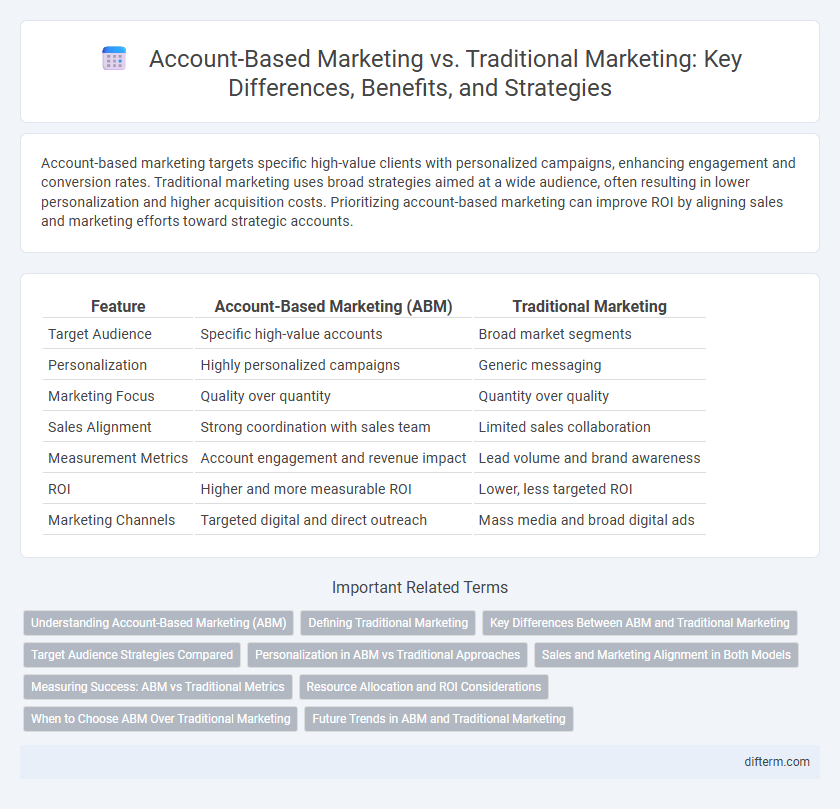Account-based marketing targets specific high-value clients with personalized campaigns, enhancing engagement and conversion rates. Traditional marketing uses broad strategies aimed at a wide audience, often resulting in lower personalization and higher acquisition costs. Prioritizing account-based marketing can improve ROI by aligning sales and marketing efforts toward strategic accounts.
Table of Comparison
| Feature | Account-Based Marketing (ABM) | Traditional Marketing |
|---|---|---|
| Target Audience | Specific high-value accounts | Broad market segments |
| Personalization | Highly personalized campaigns | Generic messaging |
| Marketing Focus | Quality over quantity | Quantity over quality |
| Sales Alignment | Strong coordination with sales team | Limited sales collaboration |
| Measurement Metrics | Account engagement and revenue impact | Lead volume and brand awareness |
| ROI | Higher and more measurable ROI | Lower, less targeted ROI |
| Marketing Channels | Targeted digital and direct outreach | Mass media and broad digital ads |
Understanding Account-Based Marketing (ABM)
Account-Based Marketing (ABM) targets high-value accounts through personalized campaigns that align closely with the specific needs and pain points of key decision-makers, enhancing engagement and conversion rates. Unlike traditional marketing's broad approach, ABM leverages detailed account insights and multi-channel strategies to deliver tailored messaging, maximizing return on investment (ROI). The strategic focus on individual accounts allows marketers to build deeper relationships and accelerate the sales cycle, making ABM a highly effective method in B2B environments.
Defining Traditional Marketing
Traditional marketing encompasses broad strategies such as print advertising, television commercials, direct mail, and cold calling, aiming to reach a wide audience without personalized targeting. It relies on mass media channels and generic messaging to build brand awareness and generate leads. This approach contrasts with account-based marketing, which focuses on highly targeted campaigns tailored to specific high-value accounts.
Key Differences Between ABM and Traditional Marketing
Account-based marketing (ABM) targets high-value accounts with personalized campaigns, leveraging precise data and collaboration between sales and marketing teams to drive engagement and conversions. Traditional marketing employs broad, mass-market strategies aimed at generating volume leads through generic messaging and diverse channels. ABM's highly focused approach yields higher ROI and alignment with sales objectives, contrasting with traditional marketing's wider reach but lower individual account targeting.
Target Audience Strategies Compared
Account-based marketing (ABM) targets specific high-value accounts with personalized campaigns, leveraging detailed data and insights for tailored messaging. Traditional marketing adopts a broader approach, casting a wide net to reach a large, generalized audience through mass media channels. ABM's precision enhances engagement and ROI by aligning marketing efforts directly with key decision-makers, contrasting with traditional marketing's focus on volume and brand awareness.
Personalization in ABM vs Traditional Approaches
Account-based marketing (ABM) delivers highly personalized campaigns tailored to specific high-value accounts, leveraging detailed data to address unique business needs and pain points. In contrast, traditional marketing relies on broader segmentation and generic messaging that targets wider audiences with less precision. This personalized approach in ABM enhances engagement and conversion rates by aligning marketing efforts closely with the individual buyer's journey and decision-making criteria.
Sales and Marketing Alignment in Both Models
Account-based marketing (ABM) fosters closer sales and marketing alignment by targeting specific high-value accounts, enabling personalized strategies that drive higher conversion rates. Traditional marketing often treats sales and marketing as separate entities, leading to generic campaigns that may not fully support the sales team's needs or target ideal buyers effectively. Strong collaboration in ABM ensures unified messaging and coordinated efforts, resulting in improved pipeline velocity and higher revenue growth.
Measuring Success: ABM vs Traditional Metrics
Account-based marketing (ABM) measures success through highly targeted metrics such as account engagement, deal velocity, and pipeline influence within specific high-value accounts. Traditional marketing emphasizes broader metrics like reach, impressions, click-through rates, and overall lead volume, which may not directly correlate with revenue generation. The precision of ABM metrics enables marketers to align efforts with revenue goals more effectively than the generalized data used in traditional marketing.
Resource Allocation and ROI Considerations
Account-based marketing (ABM) allocates resources by targeting high-value accounts with personalized campaigns, leading to more efficient spend compared to the broad reach of traditional marketing. ROI considerations favor ABM as it delivers higher conversion rates and increased revenue per account through tailored engagement. Traditional marketing requires larger budgets for mass outreach, often generating lower ROI due to less focused targeting.
When to Choose ABM Over Traditional Marketing
Account-based marketing (ABM) is ideal for B2B companies targeting high-value accounts with personalized campaigns that align sales and marketing efforts. Traditional marketing works best for broad audience reach and brand awareness across diverse market segments. Choose ABM when focusing resources on specific clients to maximize ROI and deepen customer relationships with tailored messaging and engagement.
Future Trends in ABM and Traditional Marketing
Future trends in account-based marketing (ABM) emphasize hyper-personalization using AI-driven data analytics to target high-value accounts with customized content and engagement strategies. Traditional marketing continues evolving through multi-channel integration and real-time consumer behavior tracking but lacks the precision of ABM's focused approach. The shift toward predictive analytics and automation tools signals a future where ABM delivers higher ROI by aligning sales and marketing efforts on key accounts while traditional marketing adapts to broader audience segmentation challenges.
Account-based marketing vs traditional marketing Infographic

 difterm.com
difterm.com